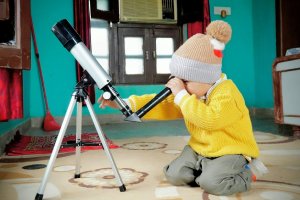Looking for the best telescope for kids? Whether your child is curious about the moon, fascinated by planets, or dreaming of becoming a space explorer, a telescope can open up a whole new universe — quite literally. Telescopes for kids aren't just toys; they're educational tools that blend fun and learning, helping children develop an appreciation for science and nature.
Spark a Lifelong Love of Astronomy

This guide is designed for parents, grandparents, and educators who want to give young stargazers a telescope that’s age-appropriate, durable, easy to use, and — most importantly — inspiring. We’ll compare top-rated models, walk through buying considerations, and answer common questions to help you make the best choice.
Best Telescopes for Kids: Top 5 Picks
1. Celestron Kids 50TT Compact Telescope
A great first scope for younger children, the Celestron 50TT is lightweight, compact, and simple to use. It features a tabletop design, making it stable and kid-friendly.
Best for: Ages 5–8
- Key Features:
- 50mm aperture
- Pre-assembled, no tools required
- Comes with a backpack and Moon map
Pros: Easy setup, travel-friendly
Cons: Limited for deep-sky viewing
2. Orion GoScope III 70mm Refractor Travel Telescope
Perfect for beginners, this 70mm refractor provides brighter images and can be used for both celestial and daytime nature viewing. It’s a dual-purpose scope that kids will love.
Best for: Ages 7–12
- Key Features:
- 70mm aperture
- Includes two eyepieces (25mm and 10mm)
- Aluminum tripod and backpack
Pros: Lightweight, portable, versatile
Cons: Tripod isn’t very tall
3. Celestron AstroMaster LT 70AZ
For children who show strong interest in astronomy, this one bridges the gap between kid scopes and adult beginner telescopes. It offers high optical quality without overwhelming complexity.
Best for: Ages 10+
- Key Features:
- 70mm aperture
- Alt-azimuth mount with slow motion controls
- SkyX planetarium software included
Pros: High-quality optics, educational software
Cons: Not ideal for very young users
4. Educational Insights GeoSafari Jr. Talking Telescope
Aimed at preschoolers, this isn't a real telescope but an interactive learning tool that teaches kids about space with fun facts and NASA images.
Best for: Ages 4–6
- Key Features:
- Voice-guided exploration
- 24 NASA images
- No assembly needed
Pros: Engaging, safe for toddlers
Cons: Not for actual sky viewing
5. Gskyer 70mm Travel Refractor
This Amazon-favorite scope combines great optics and beginner-friendly design, ideal for older kids who want to explore both the moon and some deep-sky objects.
Best for: Ages 8–14
- Key Features:
- 70mm aperture
- Includes tripod, phone adapter, and carrying case
Pros: Crisp images, excellent value
Cons: Some learning curve with adjustments
✨ James Webb Nebula Gallery
Buying Guide: How to Choose the Right Telescope for Your Child
When selecting a telescope for your child, consider these key factors:
1. Aperture Size
This determines how much light the telescope gathers. For kids, a 50mm to 70mm aperture is usually sufficient to view the Moon, planets, and some brighter stars.
2. Mount Type
Alt-azimuth mounts are easier for kids to understand compared to equatorial mounts, which require polar alignment. Simplicity is key.
3. Portability
Look for a telescope that's light enough for your child to carry or set up with minimal adult help — especially for travel or backyard stargazing.
4. Accessories
Some models include fun extras like star maps, phone mounts, or educational software — great bonuses that enhance the learning experience.
5. Budget
Kid-friendly telescopes usually range from $40 to $150. Consider how serious your child’s interest is before investing in higher-end models.
Ready to Inspire a Young Astronomer?
A child’s first telescope can ignite a lifelong passion for space, science, and exploration. Whether you're shopping for a birthday gift, a holiday surprise, or a homeschool science tool, the models listed above offer quality and excitement without overwhelming complexity.
